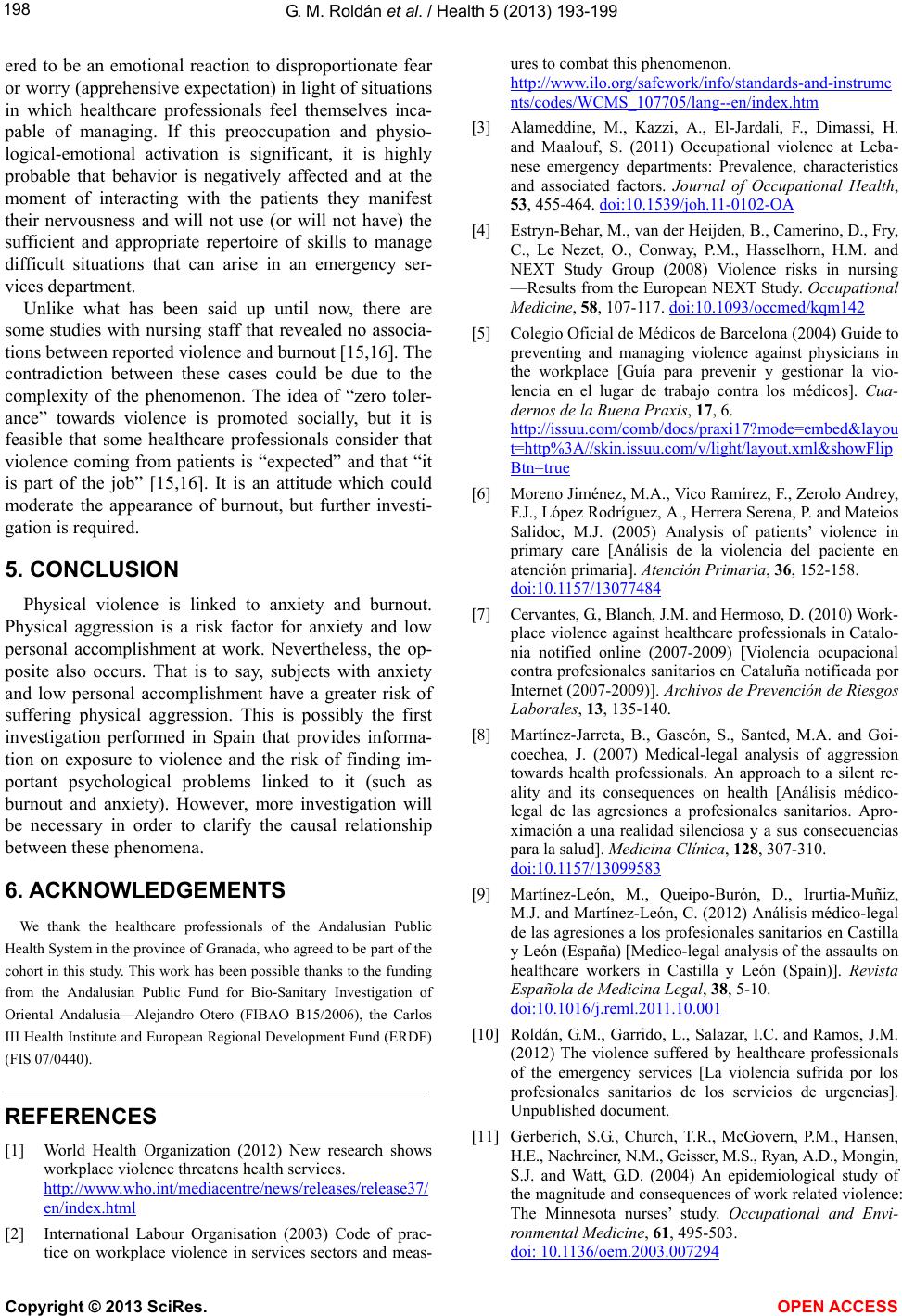
G. M. Roldán et al. / Health 5 (2013) 193-199
198
ered to be an emotional reaction to disproportionate fear
or worry (apprehensive expectation) in light of situations
in which healthcare professionals feel themselves inca-
pable of managing. If this preoccupation and physio-
logical-emotional activation is significant, it is highly
probable that behavior is negatively affected and at the
moment of interacting with the patients they manifest
their nervousness and will not use (or will not have) the
sufficient and appropriate repertoire of skills to manage
difficult situations that can arise in an emergency ser-
vices department.
Unlike what has been said up until now, there are
some studies with nursing staff that revealed no associa-
tions between reported violence and burnout [15,16]. The
contradiction between these cases could be due to the
complexity of the phenomenon. The idea of “zero toler-
ance” towards violence is promoted socially, but it is
feasible that some healthcare professionals consider that
violence coming from patients is “expected” and that “it
is part of the job” [15,16]. It is an attitude which could
moderate the appearance of burnout, but further investi-
gation is required.
5. CONCLUSION
Physical violence is linked to anxiety and burnout.
Physical aggression is a risk factor for anxiety and low
personal accomplishment at work. Nevertheless, the op-
posite also occurs. That is to say, subjects with anxiety
and low personal accomplishment have a greater risk of
suffering physical aggression. This is possibly the first
investigation performed in Spain that provides informa-
tion on exposure to violence and the risk of finding im-
portant psychological problems linked to it (such as
burnout and anxiety). However, more investigation will
be necessary in order to clarify the causal relationship
between these phenomena.
6. ACKNOWLEDGEMENTS
We thank the healthcare professionals of the Andalusian Public
Health System in the province of Granada, who agreed to be part of the
cohort in this study. This work has been possible thanks to the funding
from the Andalusian Public Fund for Bio-Sanitary Investigation of
Oriental Andalusia—Alejandro Otero (FIBAO B15/2006), the Carlos
III Health Institute and European Regional Development Fund (ERDF)
(FIS 07/0440).
REFERENCES
[1] World Health Organization (2012) New research shows
workplace violence threatens health services.
http://www.who.int/mediacentre/news/releases/release37/
en/index.html
[2] International Labour Organisation (2003) Code of prac-
tice on workplace violence in services sectors and meas-
ures to combat this phenomenon.
http://www.ilo.org/safework/info/standards-and-instrume
nts/codes/WCMS_107705/lang--en/index.htm
[3] Alameddine, M., Kazzi, A., El-Jardali, F., Dimassi, H.
and Maalouf, S. (2011) Occupational violence at Leba-
nese emergency departments: Prevalence, characteristics
and associated factors. Journal of Occupational Health,
53, 455-464. doi:10.1539/joh.11-0102-OA
[4] Estryn-Be ha r, M., van der Heijden, B., Cameri no, D. , Fry,
C., Le Nezet, O., Conway, P.M., Hasselhorn, H.M. and
NEXT Study Group (2008) Violence risks in nursing
—Results from the European NEXT Study. Occupational
Medicine, 58, 107-117. doi:10.1093/occmed/kqm142
[5] Colegio Oficial de Médicos de Barcelona (2004) Guide to
preventing and managing violence against physicians in
the workplace [Guía para prevenir y gestionar la vio-
lencia en el lugar de trabajo contra los médicos]. Cua-
dernos de la Buena Praxis, 17, 6.
http://issuu.com/comb/docs/praxi17?mode=embed&layou
t=http%3A//skin.issuu.com/v/light/layout.xml&showFlip
Btn=true
[6] Moreno Jiménez, M.A. , Vi co Ramírez, F., Zerolo Andrey,
F.J., López Rodríguez, A., Herrera Serena, P. and Mateios
Salidoc, M.J. (2005) Analysis of patients’ violence in
primary care [Análisis de la violencia del paciente en
atención primaria]. Atención Primaria, 36, 152-158.
doi:10.1157/13077484
[7] Cervantes, G., Blanch, J.M. and Hermoso, D. (2010) Work-
place violence against healthcare professionals in Catalo-
nia notified online (2007-2009) [Violencia ocupacional
contra profesionales sanitarios en Cataluña notificada por
Internet (2007-2009)]. Archivos de Prevención de Riesgos
Laborales, 13, 135-140.
[8] Martínez-Jarreta, B., Gascón, S., Santed, M.A. and Goi-
coechea, J. (2007) Medical-legal analysis of aggression
towards health professionals. An approach to a silent re-
ality and its consequences on health [Análisis médico-
legal de las agresiones a profesionales sanitarios. Apro-
ximación a una realidad silenciosa y a sus consecuencias
para la salud]. Medicina Clínica, 128, 307-310.
doi:10.1157/13099583
[9] Martínez-León, M., Queipo-Burón, D., Irurtia-Muñiz,
M.J. and Martínez -León, C. (2012) Análisis médico-legal
de las agresiones a los profesionales sa nitarios en Castilla
y León (España) [Medico-legal analysis of the assaults on
healthcare workers in Castilla y León (Spain)]. Revista
Española de Medicina Legal, 38, 5-10.
doi:10.1016/j.reml.2011.10.001
[10] Roldán, G.M., Garrido, L., Salazar, I.C. and Ramos, J.M.
(2012) The violence suffered by healthcare professionals
of the emergency services [La violencia sufrida por los
profesionales sanitarios de los servicios de urgencias].
Unpublished document.
[11] Gerberich, S.G., Church, T.R., McGovern, P.M., Hansen,
H.E., Nachreiner, N.M., Geisser, M.S., Ryan, A.D., Mongin,
S.J. and Watt, G.D. (2004) An epidemiological study of
the magnitude and consequences of work related violence:
The Minnesota nurses’ study. Occupational and Envi-
ronmental Medicine, 61, 495-503.
doi: 10.1136/oem.2003.007294
Copyright © 2013 SciRes. OPEN A CCESS